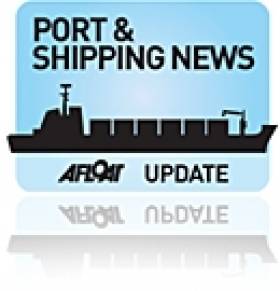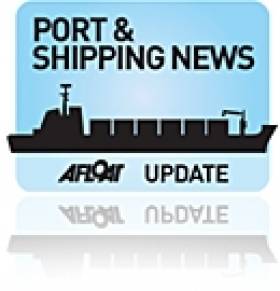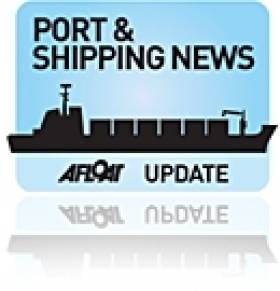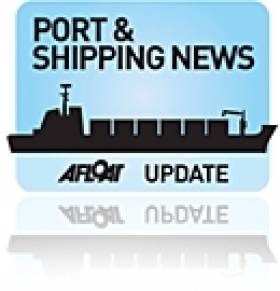Displaying items by tag: Drogheda Port Company
Continued Trade Volumes Growth at Drogheda Port
#DROGHEDA PORT – Trading volumes for Drogheda Port during the first six months of this year increased over 44% compared to the equivalent period last year. The continued rise of over 387,000 tonnes of cargo was handled with particularly strong export volumes representing 42% of total throughput volume, according to the Drogheda Port Company.
Commenting on the ports performance Chairman Mr Denis Moynihan noted that 'Drogheda Ports volume growth is particularly impressive given that is it well above the current port sector average where volumes are generally declining or stagnant.'
While the outlook for the Irish port sector for 2012 looks likely to be testing for the domestic port and shipping sectors, Drogheda Port says they expect to project above average volume increases for the remainder of 2012.
Historic First as Cruiseship Calls to Drogheda Port
#DROGHEDA CRUISE CALL – The first ever cruiseship to visit Drogheda Port was welcomed this morning as Noble Caledonia' 122 passenger Clipper Adventurer (1975/ 4,367grt) entered the mouth of the Boyne, writes Jehan Ashmore.
Onlookers came out to view the historic arrival of the 101m long vessel which normally cruises in polar waters, either Antarctica or the Arctic. She berthed at Tom Roe Terminal, downriver from the older town-centre quays, having set off from Cork earlier this month on a 10-day circumnavigation cruise of Ireland.
On board the ice-strengthened exhibition vessel were American and Canadian passengers who were on the cruise organised by Adventure Canada, in association with Royal Canadian Geographical Society. Prices for the cruise which featured a varied lecture programme started from $3,995 dollars.
Facilities include a main lounge, bar, clipper club, library/card room, gymnasium and gift shop and throughout the intimate vessel, she sports plenty of varnished wood, brass, and timber lined decks. The new outside cabins have lower beds and private facilities in addition each with window view.
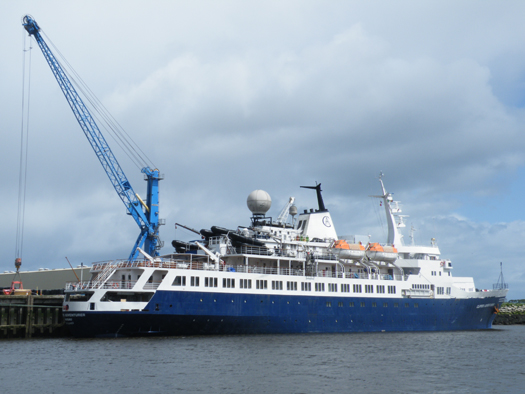
M.V. Clipper Adventurer moored alongside Tom Roes Terminal, Drogheda Port.
Photo: Jehan Ashmore
It is estimated the passenger spend generated from the cruise to the Boyne Valley is €60,000, the windfall will be a boost to the local economy. On foot of this the Drogheda Port Company has been in dialogue with a number of interested parties to build the brand and grow cruise business tourism in the region.
A small cruiseship such as Clipper Adventurer offers a more 'boutique' style of operation, in that she calls to more isolated destinations compared to the really large cruiseships. Among the ports of call on this Irish cruise they were to Kinsale, Dingle, Cliffs of Moher, Aran Islands, Westport and Tory Island.
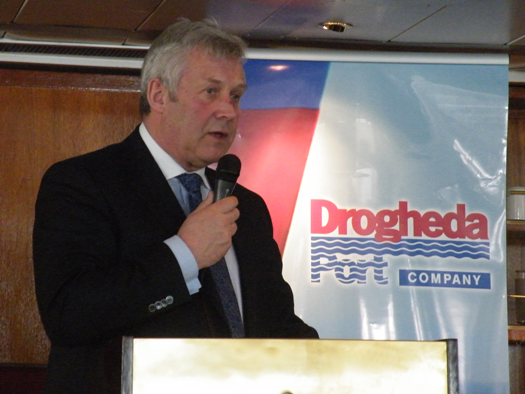
Minister of State Fergus O'Dowd speaking at a reception on board Clipper Adventurer to mark the historic cruise call visit
Where there are no port berthing facilities, passengers use instead a fleet of the vessels zodiacs which whisk them ashore to make excursions. Today her passengers disembarked to take a coach tour to the world famous visitor attractions along the Boyne Valley, before flying out of Dublin airport.
Not only is the cruise call a first for Drogheda Port but where a fly-cruise option is made available and also in reverse as the crew of the Clipper Adventurer are to welcome this evening more passengers flying in from Denmark. These passengers are to embark on a 6-day cruise of the Scottish Isles, terminating at Lerwick. The cruise is organised by Copenhagen based Albratros Tours.
First Quarter Boost for Drogheda Port
#PORTS & SHIPPING – After the first three months of 2012 Drogheda Port Company reported figures well above average in the port sector with throughput growth posting an impressive 59% increase on the corresponding period of last year.
Over 228,000 tonnes of cargo was handled by the Co. Louth port and for the first time the balance of trade in the port equalised with 50% of the volume represented by imports and 50% of the volume represented by exports.
The volume growth at the port is very much export led with a number of indigenous industries focusing on the European and UK markets as outlets for their products.
As previously reported on Afloat.ie a new tonnage record was set in January when the Arklow Bridge (2011/4,723grt) carrying 7,175 tonnes of maize representing the largest ever single cargo handled in the port.
Mr Paul Fleming, Drogheda Port Chief Executive said "Drogheda Port continues to provide a strategic import/export location for our customers with a service more flexible and cost competitive than other larger ports. This is helping us to win new contracts and grow our business".
He added: "The ports performance demonstrates the economy is rebalancing towards exports at a time when our economic recovery is very much dependent on being driven by our exporting firms."
The outlook for the Irish port sector for 2012 looks likely to be testing for the domestic port and shipping sectors and according to the port they project to continue above average volume increases for the year.
In May the port can look forward to hosting its first cruise call by the Clipper Adventurer (1975/4,367grt) as previously reported. The vessel will be undertaking its inaugural circumnavigation of the island of Ireland visiting a number of destinations including Drogheda and the Boyne Valley.
Arklow Vessel Sets Record Cargo for Drogheda Port
#PORTS & SHIPPING – Drogheda Port set a record tonnage cargo with the arrival of Arklow Bridge (2011/4,723grt) last week. The vessel operated by Arklow Shipping N.V. as previously reported on Afloat.ie had carried 7,125 tonnes of maize, the largest ever single cargo handled in the Co. Louth port, writes Jehan Ashmore.
Arklow Bridge is the second 'B' class vessel that was built last year and the Dutch-flagged vessel loaded the cargo of maize in the Polish city of Gdynia for Comex McKinnon. The company is a leading player in the importation and trading of feedstuffs for the animal feed sector in Ireland.
Stevedoring services were handled by Fast Terminals, a new company which is a joint venture between Drogheda Port Company and Fast Shipping of Antwerp. The company became operational last Septemberand increases the number of stevedoring operations in the port to four.
Drogheda Port is developing its agri-sector business so to transport feedstuffs for the animal feed sector in Ireland. The agri-food sector is worth €7.8bn and is proving resilient, despite the downturn and growth from this indigenous sector will be vital to the country's overall economic recovery.
According to Drogheda Port Company, planning permission was recently received for the development of a 5,400sq m bulk storage facility at the Tom Roes Point Terminal. The downriver facility is situated closer to the open sea compared to the towns quays on the banks of the Boyne.
Mr Paul Fleming, Drogheda Port Chief Executive said "Drogheda Port continues to provide a strategic import and export location for our customers with a service which is more flexible and cost competitive than other larger ports".
He added: "This is helping us to win new contracts and grow our business in addition to providing a platform to Ireland's importers and exporters to reach their markets more cost competitively."
Mr Simon Mulvany, Director of Fast Terminals said "Fast Terminals has identified the competitive opportunities that Drogheda Port can offer our company. Despite the current economic downturn we intend to invest in the port and develop our facilities to cater for further growth in the future."
Former Dutch Dredger on the Boyne
#PORTS & SHIPPING- Berthed at the Steam Packet Quay, Drogheda is the suction-trailer dredger Lough Foyle (1979/868grt) which is on contract work with the Drogheda Port Company, writes Jehan Ashmore.
Following the sale last month of Hebble Sand, as previously reported on Afloat.ie (clcik HERE), the Lough Foyle (PHOTO) is now the only port-owned dredger on the island of Ireland. The Londonderry Port & Harbour Commissioners (LPHC) purchased the vessel from Dutch interests in 2009. She was originally the Saeftinge, built in 1979 at the Van Goor Scheepswerf in Monnickendam.
Since her introduction she has performed previous dredging operations to include the Drogheda Bar leading into the Co. Louth port. Her most recent contract was in Waterford Estuary, from where she arrived from on Tuesday after an overnight voyage.
In addition she has worked at the new Stena Line ferryport terminal at Loch Ryan, Cairnryan, to see related report click HERE. The Scottish ferryport is due to be officially opened tomorrow, to read more including the newly introduced 'Superfast' sisters click HERE.
Bremore Survey Indicates New Push for Port Development
Drogheda Port Company is seeking tenders to carry out geological investigations off Bremore Head near Balbriggan, the Sunday Business Post reports.
The port company and partner Treasury Holdings had been working with Hong Kong-based Hutchison Whampoa on plans for a new port in the north Co Dublin area, set to have a starting freight capacity of 10 million tons per year.
Treasury Holdings says the survey is intended to help avoid developing on a location that could interfere with historic sites, after An Taisce voiced its opposition to any port scheme that would impact on an archaeologial site running from Bremore to the mouth of the River Delvin.
An Taisce is also opposed to another proposed site at Gormanston.
Drogheda Port Company CEO Paul Fleming could not be contacted by the Sunday Business Post to comment on whether the tender indicates a decision to move forward with plans for a port at Bremore.
Minister for Transport Leo Varadkar said he supported the bid to develop a new facility at Bremore, after a previous move to extend the boundaries of Drogheda port were halted by legislative limits that have since been amended.
The Sunday Business Post has more on the story HERE.
Varadkar Supports Deepwater Port at Bremore
Drogheda Port Company successfully managed to navigate the global economic downturn with an improved and solid performance for 2010, delegates where informed during its annual report released yesterday, writes Jehan Ashmore.
Speaking about the performance of Drogheda Port Company, Leo Varadkar TD, Minister for Transport, Tourism and Sport said; "I congratulate the company on its solid trading performance in 2010 following a difficult year in 2009. Both imports and exports through the port returned to growth in 2010. The company has managed its costs well and remains profitable. I support the company's plans to develop the existing port and indeed to continue to progress its proposal for a new deepwater port at Bremore.
The Minister added "this country's return to economic prosperity will be export-led and Irish ports will play an important role in facilitating that trade. The overall structure of the State's ports will be reviewed later this year as part of the current Ports Policy Review and will take account of the recent recommendations of the McCarthy Group. Irrespective of the outcome, well managed and profitable ports such as Drogheda will continue to play an important role in serving the market and facilitating industry and jobs.
As part of the ongoing the Ports Policy Review a Consultation Document was issued in October 2010, which highlighted the important role of ports to facilitate the return to economic growth when it occurs. In addition new capacity will be required in the medium to long term and this needs to be planned for now.
The consultation also acknowledges the continuing trend towards larger ships requiring deep-water ports, the reduced availability of ships to serve smaller ports and the emergence of the concept of port-centric logistics as a key driver for future port development.
As for this year "a number of new port records were established in 2010" said Mr. Paul Fleming, Drogheda Port chief executive. "In March, the longest ever vessel to be accommodated in the port, the Rusich 1 at over 128m in length berthed at Tom Roes Point Terminal". The 4,970 tonnes vessel arrived from Vyborg, Russia with a cargo of fertiliser.
Mr Fleming also referred to the largest gas tanker ever to visit its facility at the Flogas LPG terminal when the 1,720 dwt tonnes Thresher docked last October. The Dutch flagged Thresher had arrived loaded with a cargo from the Whitegate Refinery, Cork Harbour and is operated by Chemgas which operate one of the most modern gas carrier fleets in the world.
In addition to last year's performance, first quarter figures for 2011 were revealed with trading volumes reporting an increase of 18% based from the same quarter for last year. The rise was primarily driven by export volumes of existing and new commodities.
New Life for Bremore Port Development
Drogheda's port company has redrafted its plan to develop a €300 million deepwater harbour in north Dublin.
The semi-State Drogheda Port Company previously failed to get approval from then Transport Minister Noel Dempsey when it first submitted proposals for the port at Bremore, near Balbriggan, in 2009.
The Sunday Business Post reports that the project would require a Ministerial Order to sanction the extension of Drogheda port's boundaries into Co Dublin under the Harbours (Amendment) Act 2009.
Previously any such extension would have been "legally problematic", in the words of Attorney General Paul Gallagher.
No planning application has yet been made, but partners in the venture are reported to be making preparations.
A public consultation on the previous proposals was conducted in September 2009.
Volumes Increase at Drogheda Port
In order to facilitate the recovery of the economy, ports with increased capacity will play a vital strategic role in expanding export-driven trade. Plans by the Drogheda Port Company to the development of a proposed new port at Bremore in north Co. Dublin, remain a key objective of the company, with a planning application currently in preparation.
Irish cargo-ship remains aground off Drogheda Port
The Drogheda Port Company's patrol launch, Boyne Protector has been monitoring the situation as the Arklow Raider lies close to the entrance of the Co. Louth port.






























